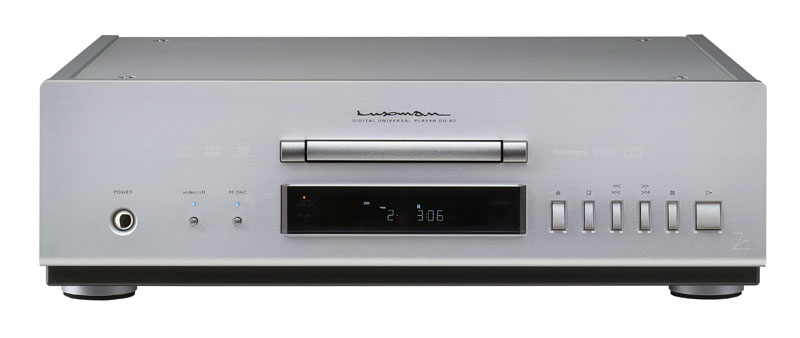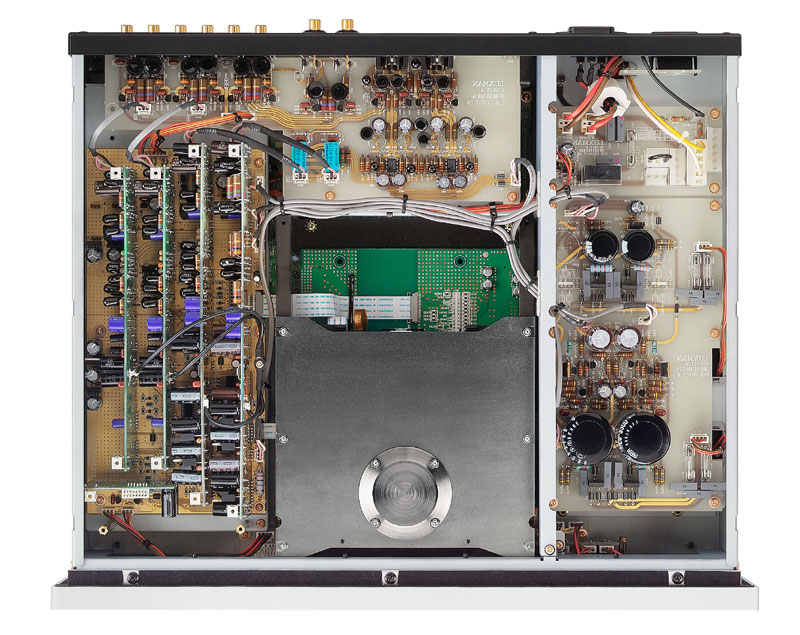 February 17, 2009
Luxman DU-80 Universal A/V Player
Late in the
review period for the Luxman L-509u integrated amplifier that I wrote about
earlier this month, Luxman’s gregarious bon vivant Philip O’Hanlon
dropped in for a listening session. In addition to his usual fistful of personally
compiled demo discs, he brought along Luxman’s DU-80 universal player ($10,500 USD).
In addition to Red Book CDs, the DU-80 plays SACDs, DVD-Audio and DVD-Video discs, CD-Rs
and Video CDs. It is also capable of handling both two-channel and multichannel
recordings. For decoding the digital datastream, the DU-80 employs two proprietary DACs
that can be selected via a button on the front panel: the Fluency DAC for Red Book CD and
the Shannon DAC for SACD and DVD-Audio. The Fluency DAC is a time-coherent design that is
said to produce a stress-free sound closer to that of analog reproduction. The Shannon DAC
is frequency coherent, capable of delivering the extra resolution, greater transparency
and enhanced ambience retrieval of DVD-Audio or SACD discs. My time with the DU-80
involved evaluating only its stereo audio performance.

O’Hanlon recommended that I start with Red
Book CD and allow the Fluency DAC a few days to warm up and settle in. After some casual
listening to some favorite jazz CDs, I got down to business. First up was the remastered
version of the classic Who’s Next [MCA MCAD-11269]. Having listened to this
album, first on LP and then on CD, regularly for more than 25 years, I know it probably
better than any other in my library, but via the DU-80 it sounded fresh and vital. The
DU-80 didn't just flaunt its resolving powers; I heard deeper into the recording,
as if vocal was layered upon guitar, guitar upon bass, bass upon keyboards, and everything
upon the drums, without any sense of confusion or congestion, even at high volumes. Even
better, the musical ebb and flow -- the ability for the music to simply appear without
seeming forced out of the speakers -- were the best I have yet heard from the CD format.
With classical music, the sound was even more impressive, with such acute reproduction of
reverb and decay that the hall sound was as realistic as I’ve heard with CD. On
"Fanfare for the Common Man" from a remastered Gershwin/Copland performance
conducted by Lorin Maazel and Zubin Mehta [London 417 716-2 LM], the opening
tympani-mallet strikes were so forceful as to be startling, then as the brass began the
majestic fanfare, the sound ricocheted off of the hall’s walls, throwing a very wide
and deep soundstage that was almost spooky.

Prior to my review of the Wadia 581ise, my
experience with high-resolution formats was so limited that the Wadia player really served
as my introduction. And honestly, while the differences between Red Book CD and SACD were
apparent, they were most perceptible with symphonic music and live jazz recordings. Not so
with the DU-80. One of the SACDs that I used to evaluate the 581ise was the Rolling
Stones’ Beggar’s Banquet [ABKCO 95392]. While both the CD and SACD layers
sounded superb through the Wadia player, I didn’t notice an appreciable difference
between the two layers. With the DU-80, not only was there a noticeable sonic improvement
with both layers over the 581ise, the SACD layer differentiated itself from the CD layer
with more tightly focused, three-dimensional images and a much deeper soundstage. The same
thing could be said for the late Michael Brecker’s final album, Pilgrimage
[Heads Up HUSA 9095]. On my favorite track, the harmonically dense "Tumbleweed,"
as Brecker plays his solo, Brad Mehldau’s piano playing can be heard as a subtle
accompaniment, his piano runs intertwining with Brecker’s sax. The SACD layer clearly
delineated all of this.
I have even less experience with DVD-Audio and
have no DVD-A discs in my library, so I had to rely on some compilation DVD-As that Philip
provided. Although I was unfamiliar with the music, I had similar feelings about the
overall resolution and soundstaging. As to which was the better format, I’d have to
say it was a toss-up in light of the limited time I spent with the DU-80.
Although the high-rez formats exceeded the
resolution of Red Book CD, all did share one common trait with the DU-80: There was a
relaxed presentation and a more natural flow to the music than I’ve experienced with
other players. The Luxman DU-80 is the most analog-sounding digital player I’ve ever
heard, with ease and liquidity that never once approached becoming analytical or
mechanical. These qualities were even more noticeable when the DU-80 was paired with the
L-509u, perfectly complementing its finest qualities with regard to pace, rhythm and
timing.
To hear the DU-80 is to want it, and boy do I
want it!
...Uday Reddy
uday@soundstage.com
|

